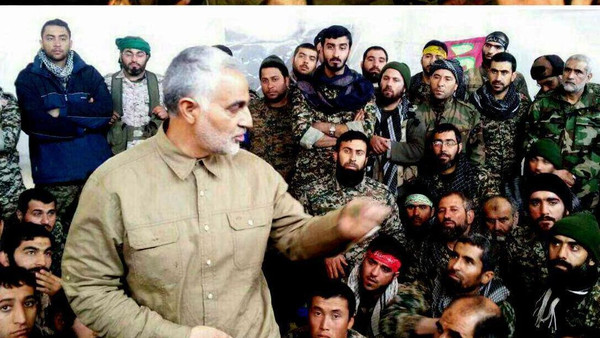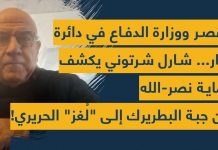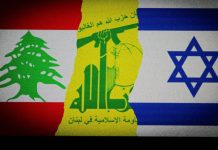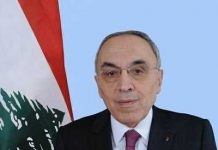Soleimani’s Occupations by War, Peace or Agreements
Eyad Abu Shakra/Asharq Al-Awsat English/December 28/16
Those who are familiar with how Iran’s political institutions work explain General Qassem Soleimani’s intended appearances in pictures and films shot in Arab battlefields where his militias fight, and the broadcasting of them on TV and online social networks, as part of the ‘psychological warfare’ that Tehran has mastered.
Soleimani, Commander of the IRGC’s ‘Quds Brigade’, is himself engaged in a fight for influence within Iran’s security and military establishment which is currently the backbone of the country’s power structure under the nominal ‘legitimacy’ of the ‘Vali e Faqih’. ‘Elected’ and selected councils, as well as religious authorities, the presidency and the prime minister’s posts are now of secondary importance compared to the real ‘centre of power’ which comprises the interests networks of the security and military apparatuses – led by the IRGC – and its financial mafias; albeit, under the cloak of ‘the Supreme Guide’ Ali Khamenei.
Thus, Soleimani and his mates in the IRGC and other security and military apparatuses are the ones who today call the shots, decide the national political agenda, and plan and execute Iran’s adventures abroad. Furthermore, even, when recalling that most of what is being uttered in the now familiar arrogance may not be true but is primarily reserved for ‘local consumption’, and that Iran’s internal situation is much worse than we are led to believe by Tehran propaganda organs, one has to accept that the better part of Tehran’s arrogance is helped by very helpful and accommodating regional and global conditions.
Indeed, it was recently reported that things are not all well between Tehran’s leading players and some of its influential lobbyists in Washington who have different approaches and tactics. However, reliable observers do not see these emerging differences as a critical problem in dealing with Washington under Donald Trump unless the anti-Iran forces and those at the receiving end of Tehran’s aggression and expansionism succeed in establishing a solid understanding based on common interests with the incoming Trump administration.
Frankly, one has to regard Tehran’s achievements in both Iraq and Syria as outright victories. Tehran has also managed to reach an agreement with Washington leaving it the freedom to do as it pleased throughout the Middle East, and tie up its tactical interests with those of Russia despite the historical Russo-Iranian animosities in the southern Caspian Sea basin.
The Iranian de facto occupation of Iraq began with the 2003 US-led attack and occupation, and gathered pace under the Coalition Provisional Authority which dismantled Iraqi state institutions and ‘gifted’ the country to pro-Iran sectarian factions; and now this Pax Iranica is obvious after the successive governments of Ibrahim Jaafari, Nuri Al-Maliki and Haider Al-Abadi. In the meantime, while the Kurdish north is all but an ‘independent state’, the only part of Iraq whose position remains ambiguous in the atmosphere of Iranian hegemony is the Arab Sunni part awaiting the outcome of the battle for Mosul and the clarification of the relationship of the Mid-Euphrates (Al-Anbar) with the central government in Baghdad.
The overall picture is not much different in Syria now that the Russia – Iran alliance is applying the final touches on the desired demographic change in ‘Useful Syria’ through systematic mass population displacement under full international auspices. This displacement, or rather ‘cleansing’ is being meticulously conducted regionally and internationally through multi-party talks and meetings that began in Geneva and may not end in Astana, the capital of Kazakhstan.
In other Syrian areas, while the situation in the ‘militarily-frozen’ south seems to be controlled by coded messages between Israel on one side and the Assad regime, Soleimani’s bunch, and Putin’s protectorate on the other, Washington continues to bet on Kurdish secessionist ambition in northern Syria under the pretext of fighting ISIS. Finally, eastern Syria, i.e. Deir Ez-Zor Province is left to share the same fate with the Iraqi part rest of the Mid-Euphrates basin.
Last but not least, there is Lebanon. Here the majority in both the Christian and Sunni Muslim communities thought they finally managed to “save” Independent Lebanon by electing a ‘strong’ Maronite Christian with majority support as President, and appointing a ‘strong’ Sunni with a majority support as Prime Minister. They felt that the two men (Michel Aoun and Saad Al-Hariri) would be able to end Lebanon’s ‘political vacuum’ which lasted for around two and a half years. But while most level-headed Lebanese knew deep inside that the ‘vacuum’ was only the tip of the ‘iceberg’, and that the reality was much more serious, they gave this development the benefit of the doubt, and trusted yet again promises that have been proven to be worthless. The grantor of these promises was the ‘force of the Status Quo’ – i.e. Hezbollah – that receives its orders from abroad while exercising its ‘occupation’ of the country, permeating all government institutions, and unilaterally fighting regional wars that serve the interests of its regional master, Iran.
This ‘occupation’ is now about to be legitimized by an ‘electoral law’ demanded by Hezbollah, and would contribute to the ongoing process of the IRGC’s occupation of Syria; noting that the latter is taking shape through sectarian cleansing of regions, towns and cities like Qusair, Homs and Aleppo, as well as that in the greater Damascus region with the intention of bolstering its defences and linking it with the Shi’ite human reservoir in neighbouring Lebanon.
In fact, Hezbollah – an organ of the IRGC and a follower of Vali e Faqih – has done its share in changing the demographic map of Lebanon, through its military adventures that damaged the country’s economy, driving hundreds of thousands of Lebanese to emigrate.
Thus, one needs to reflect when seeing Qassem Soleimani’s pictures in front of Aleppo’s historic citadel, the weeping displaced being driven away in the regime’s green buses in a journey of sectarian population exchange, and hearing of forced ‘conciliations’ under threat of famine and murder.
Yes, one must reflect and think, as the international community chatters about fighting terrorism, fighting extremism, and supporting ‘legitimacy’ through conferences and deals designed – in reality – to facilitate the redrawing of the Middle East map.
We are indeed at a threshold of a regional situation totally different from the one in place around 100 years ago. In this new situation there will surely be winners, losers and the departed; and it is our duty to realise the magnitude of its critical challenges.





















